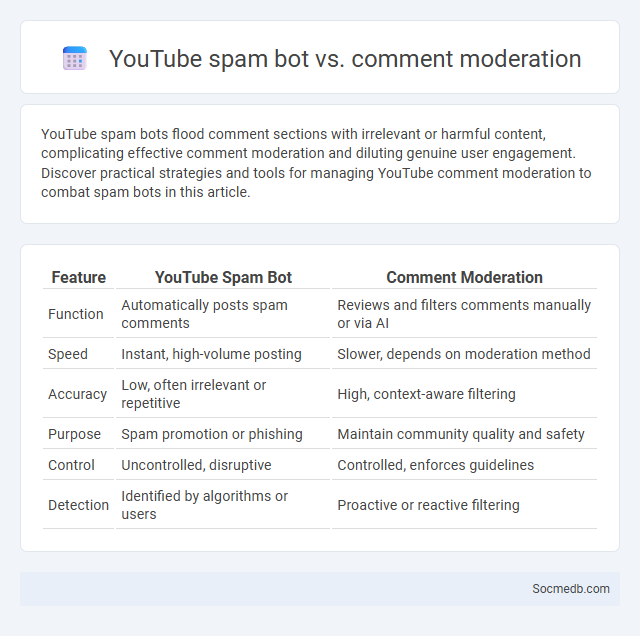
Photo illustration: YouTube spam bot vs comment moderation
YouTube spam bots flood comment sections with irrelevant or harmful content, complicating effective comment moderation and diluting genuine user engagement. Discover practical strategies and tools for managing YouTube comment moderation to combat spam bots in this article.
Table of Comparison
| Feature | YouTube Spam Bot | Comment Moderation |
|---|---|---|
| Function | Automatically posts spam comments | Reviews and filters comments manually or via AI |
| Speed | Instant, high-volume posting | Slower, depends on moderation method |
| Accuracy | Low, often irrelevant or repetitive | High, context-aware filtering |
| Purpose | Spam promotion or phishing | Maintain community quality and safety |
| Control | Uncontrolled, disruptive | Controlled, enforces guidelines |
| Detection | Identified by algorithms or users | Proactive or reactive filtering |
Understanding YouTube Spam Bots
YouTube spam bots flood comment sections and live chats with irrelevant links, misleading promotions, and repetitive messages to manipulate user engagement and algorithm rankings. Your awareness of these fake accounts helps protect your channel's credibility and ensures authentic audience interaction. Identifying patterns like unnatural posting frequency, generic usernames, and irrelevant content is crucial for maintaining a safe YouTube community.
How Comment Moderation Works on YouTube
YouTube comment moderation uses automated filtering tools and manual review to manage content quality and enforce community guidelines. Algorithms detect spam, offensive language, and inappropriate content, while creators can set filters for specific keywords and approve comments before they appear publicly. This combination helps maintain a safe and engaging environment for viewers and content creators.
Types of Spam Bots on the Internet
Spam bots on the internet include comment bots that flood social media posts with irrelevant or promotional content, follower bots designed to artificially inflate user follower counts, and phishing bots that distribute malicious links to steal personal information. These bots exploit automation to manipulate engagement metrics and spread misinformation rapidly across platforms like Instagram, Twitter, and Facebook. Effective detection techniques rely on analyzing behavioral patterns such as high-frequency posting and repetitive messages to mitigate their impact on user experience and platform integrity.
Identifying Spam in YouTube Comments
Identifying spam in YouTube comments involves analyzing patterns such as repetitive messages, excessive links, and irrelevant content that disrupts genuine conversations. YouTube's algorithm uses machine learning to detect and filter out comments containing promotional links, scams, or offensive language, improving the overall user experience. Protect Your channel by reporting suspicious comments and enabling comment moderation features to maintain a healthy community interaction.
Impact of Spam Bots on YouTube Channels
Spam bots on YouTube channels significantly distort your audience analytics by inflating views and engagement with fake interactions, leading to misleading performance metrics. These bots can harm your channel's credibility and reduce organic reach as platform algorithms detect and penalize abnormal activity patterns. Protecting your content from spam bots ensures genuine viewer interaction, preserving your channel's growth and reputation.
Effectiveness of YouTube’s Comment Moderation Tools
YouTube's comment moderation tools enhance community engagement by filtering spam, inappropriate content, and harassment, ensuring a safer environment for your audience. Features like automated filters, keyword blocking, and AI-driven toxicity detection allow creators to maintain high-quality, relevant conversations. Using these tools effectively boosts your channel's reputation and fosters meaningful interactions that support growth.
Comparing YouTube Spam Bots and General Spam Bots
YouTube spam bots primarily target video comments and live chats to promote fake views, subscriptions, and malicious links, leveraging the platform's engagement metrics for increased visibility. General spam bots operate across various digital channels such as email, social media platforms, and forums, spreading unsolicited messages, phishing attempts, and malware on a broader scale. Understanding the specific behaviors of YouTube spam bots helps you implement tailored security measures to protect your channel from fraudulent activities and maintain genuine audience interaction.
Strategies to Combat Spam Bots on YouTube
Effective strategies to combat spam bots on YouTube include implementing robust CAPTCHA tests during user interactions and using machine learning algorithms to detect suspicious behavior patterns. Monitoring comment sections for repetitive, irrelevant content helps maintain genuine engagement and protects your community from spam. Regularly updating filters and leveraging YouTube's moderation tools empower you to safeguard your channel against automated spam attacks.
Enhancing Comment Moderation for Better Engagement
Enhancing comment moderation on social media platforms improves user engagement by fostering respectful and meaningful interactions. Implementing AI-driven filters and real-time monitoring tools helps detect and remove spam, hate speech, and abusive content efficiently. These strategies create a safer online environment, encouraging users to participate actively and share authentic opinions.
The Future of Spam Detection on YouTube
Advancements in artificial intelligence and machine learning are revolutionizing spam detection on YouTube, enabling the platform to identify and remove harmful content more efficiently. Your account's security will benefit from real-time filtering systems that analyze user behavior patterns and comment characteristics to prevent spam before it spreads. Enhanced algorithms continuously adapt to new spam tactics, ensuring a safer and more engaging experience for creators and viewers alike.
 socmedb.com
socmedb.com